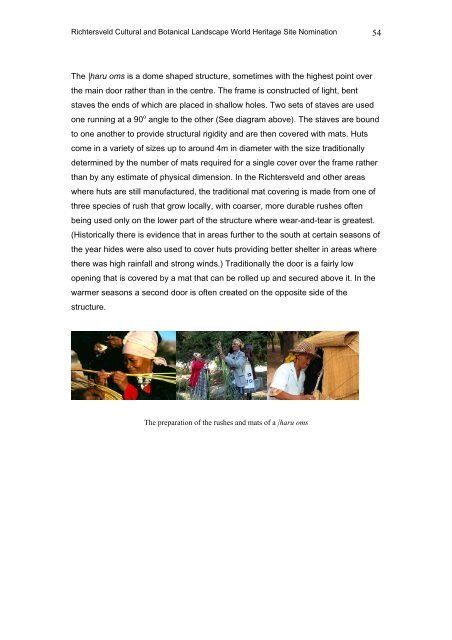the richtersveld cultural and botanical landscape - SAHRA
the richtersveld cultural and botanical landscape - SAHRA
the richtersveld cultural and botanical landscape - SAHRA
You also want an ePaper? Increase the reach of your titles
YUMPU automatically turns print PDFs into web optimized ePapers that Google loves.
Richtersveld Cultural <strong>and</strong> Botanical L<strong>and</strong>scape World Heritage Site Nomination 54<br />
The |haru oms is a dome shaped structure, sometimes with <strong>the</strong> highest point over<br />
<strong>the</strong> main door ra<strong>the</strong>r than in <strong>the</strong> centre. The frame is constructed of light, bent<br />
staves <strong>the</strong> ends of which are placed in shallow holes. Two sets of staves are used<br />
one running at a 90 o angle to <strong>the</strong> o<strong>the</strong>r (See diagram above). The staves are bound<br />
to one ano<strong>the</strong>r to provide structural rigidity <strong>and</strong> are <strong>the</strong>n covered with mats. Huts<br />
come in a variety of sizes up to around 4m in diameter with <strong>the</strong> size traditionally<br />
determined by <strong>the</strong> number of mats required for a single cover over <strong>the</strong> frame ra<strong>the</strong>r<br />
than by any estimate of physical dimension. In <strong>the</strong> Richtersveld <strong>and</strong> o<strong>the</strong>r areas<br />
where huts are still manufactured, <strong>the</strong> traditional mat covering is made from one of<br />
three species of rush that grow locally, with coarser, more durable rushes often<br />
being used only on <strong>the</strong> lower part of <strong>the</strong> structure where wear-<strong>and</strong>-tear is greatest.<br />
(Historically <strong>the</strong>re is evidence that in areas fur<strong>the</strong>r to <strong>the</strong> south at certain seasons of<br />
<strong>the</strong> year hides were also used to cover huts providing better shelter in areas where<br />
<strong>the</strong>re was high rainfall <strong>and</strong> strong winds.) Traditionally <strong>the</strong> door is a fairly low<br />
opening that is covered by a mat that can be rolled up <strong>and</strong> secured above it. In <strong>the</strong><br />
warmer seasons a second door is often created on <strong>the</strong> opposite side of <strong>the</strong><br />
structure.<br />
The preparation of <strong>the</strong> rushes <strong>and</strong> mats of a |haru oms

















